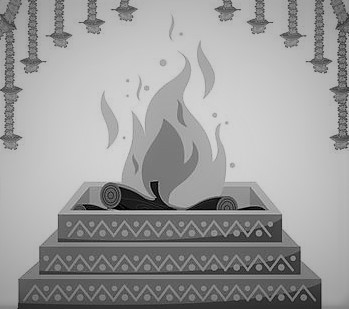
The Origins of the Vedic Wedding Ceremony/ ವೈದಿಕ ವಿವಾಹ ಸಮಾರಂಭದ ಮೂಲಗಳು
Info base
The Origins of the Vedic Wedding
Ceremony
ವೈದಿಕ ವಿವಾಹ ಸಮಾರಂಭದ ಮೂಲಗಳು
v चतुर्णां आश्रमाणां हि गार्हस्थ्यं श्रेष्ठमाश्रमं
ಮನೆಯನ್ನು ಸ್ಥಾಪಿಸುವ ಜವಾಬ್ದಾರಿಯು ವೇದಗಳಲ್ಲಿ ಬೇರುರಿದೆ. ವೈದಿಕ ವಿವಾಹ ಸಮಾರಂಭದ ಮೂಲಗಳು ಮತ್ತು ಇತಿಹಾಸವನ್ನು ಅರ್ಥಮಾಡಿಕೊಳ್ಳಲು, ಪುರಾತನ ಪದಗಳು ಮತ್ತು ಸನ್ನೆಗಳ ಹಿಂದಿನ ಮನೋಭಾವವನ್ನು ವಿವರಿಸುತ್ತವೆ. ಹಲವಾರು ಶತಮಾನಗಳ ಕಾಲದ ಅವರ ಸಿಂಧುತ್ವ ಮತ್ತು ನಿಗದಿತ ವಿಧಿವಿಧಾನಗಳು (ಸಂಸ್ಕಾರಗಳು) ವೈದಿಕ ಅಭ್ಯಾಸದ ಸಮಯಾತೀತ ಗುಣಮಟ್ಟವನ್ನು ಹೆಚ್ಚಿಸುತ್ತವೆ.
ಮದುವೆಯ ಆರಂಭಿಕ ಉಲ್ಲೇಖವು ಋಗ್ವೇದದಲ್ಲಿ ಕಂಡುಬರುತ್ತದೆ. ಕೆಳಗಿನ ಸಂಕ್ಷಿಪ್ತ ವಿವರಗಳಲ್ಲಿ ವಿವರಿಸಲಾದ ಸಮಾರಂಭವು ಇಂದಿನ ಹಿಂದೂ ವಿವಾಹ ಸಮಾರಂಭಗಳಿಗೆ ಹೋಲಿಸಿದರೆ ಬಹಳ ಸರಳವಾಗಿದೆ, ಆದರೂ ಮೂಲಭೂತ ರಚನೆಯು ಒಂದೇ ಆಗಿರುತ್ತದೆ. ಇದು ಸೂರ್ಯನ ಮಗಳು, ಚಂದ್ರನ ದೇವರು ಸೋಮನ ವಿವಾಹ ಸಮಾರಂಭವಾಗಿದೆ. ಹಿಂದೂ ವಧುವು ಸೂರ್ಯನ ಮಾನವ ಅವತಾರ ಎಂದು ನಂಬಲಾಗಿದೆ, ಆಕೆಯ ಹಿಂದಿನ ಜೀವನದಲ್ಲಿ, ದೈವಿಕ ಕುಟುಂಬದ ಸದಸ್ಯನಾಗಿ, ಸೋಮನನ್ನು ಮತ್ತು ನಂತರ ಗಂಧರ್ವನನ್ನು ಮತ್ತು ನಂತರ ಅಗ್ನಿಯನ್ನು ವಿವಾಹವಾದಳು.
The Origins of the Vedic Wedding
Ceremony
चतुर्णां आश्रमाणां हि गार्हस्थ्यं श्रेष्ठमाश्रमं
Among the four stages of life, that of the householder
is the best
Prince Bharata said these words in
the Ramayana to persuade his elder brother Rama to postpone his exile in the
forest and return to Ayodhya to rule the kingdom and resume everyday life. Each
stage is appropriate to the age of the concerned individual, and all are
considered equally important to achieve salvation (moksha or final release from
rebirth). Barring extraordinary reasons, one is urged not to abandon the
responsibilities due at each stage. The householder stage is when the
individual is fully equipped, both physically and mentally, to perform his
duties to himself, his family, his community, his country and even to the world.
Therefore, this stage is considered the most important. Bharata argued that, as
a young man and the eldest brother, Rama had a duty that was more appropriate
to his age—to become the king.
The responsibility to set up a
household has its roots in the Vedas; let’s revisit these origins. Understanding
the origins and history of the Vedic wedding ceremony helps explain the spirit
behind the ancient words and gestures and the reason for their continuing
strong hold on young and old. Their validity over several centuries and the
prescribed rites of passage (samskaras) add to the timeless quality of Vedic
practice.
The earliest reference to a wedding
is found in the Rig Veda. The ceremony, which is described in concise detail below,
was pretty simple compared to the Hindu wedding ceremonies of today, though the
basic structure is the same. This is the wedding ceremony of Suryā, the
daughter of Surya, the sun god, to Soma, the moon god. It is believed that a
Hindu bride is a human incarnation of Suryā herself, who, in her earlier lives,
as a member of a divine family, was married to Soma, and later to a Gandharva
and then to Agni, and is now ready to be married to another human.
सोम: प्रथमो विविदे गन्धर्वाे विविद उत्तर:
tṛtīyogniṣṭe patisturo yaste manuśyajāha
Soma obtained her first of all; next, the Gandharva was her
lord.
Agni was thy third husband; now one born of woman is thy
fourth.
This is why couples offer their first oblations to these
former husbands during the fire ritual. It is important to note how the shloka
first refers to Suryā in the third person and then shifts to the second person,
‘thy’, to address a current bride. An account of Suryā’s wedding ceremony is
found in mandala 10, hymn 85 of the Rig Veda.
Reference: THE VEDIC WEDDING BOOK (A.V.
SRINIVASAN)
Translated By: SNH Vivaha
v Please comment your opinions to our
email id: vivaha@snhcorp.in